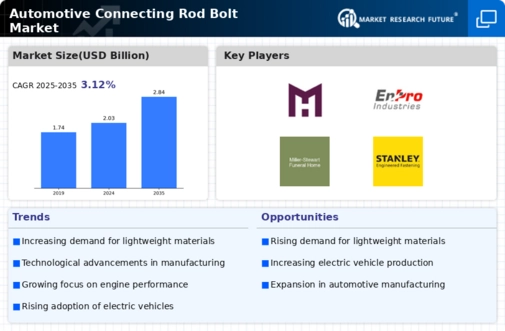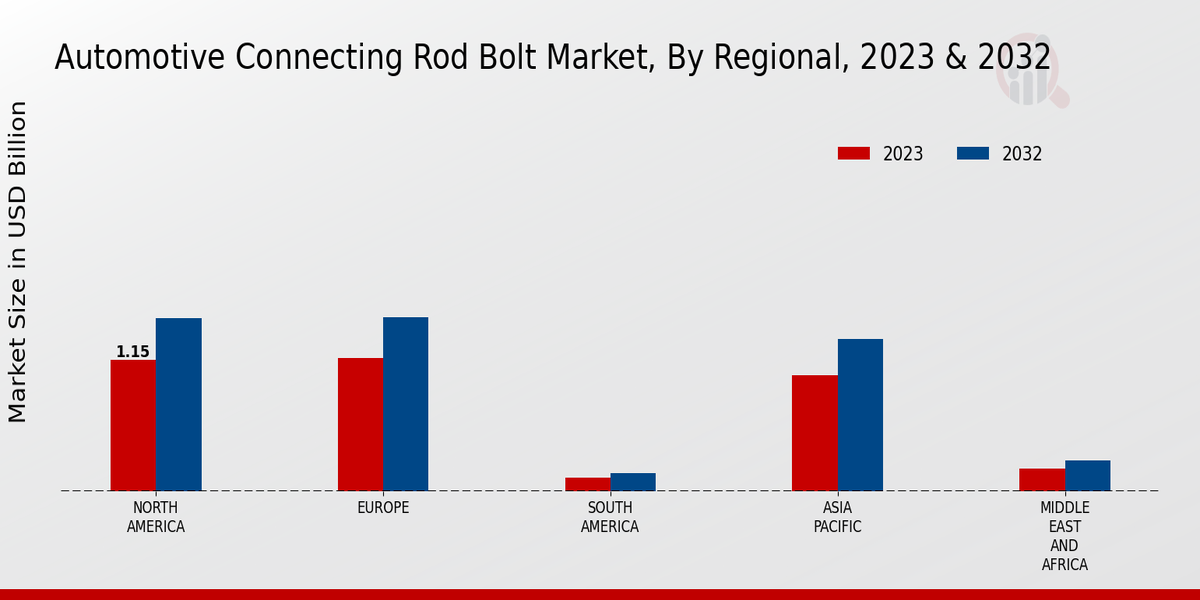Increasing Vehicle Production
The Global Automotive Connecting Rod Bolt Market Industry is experiencing growth driven by the rising production of vehicles worldwide. As manufacturers ramp up output to meet consumer demand, the need for high-quality connecting rod bolts becomes paramount. In 2024, the market is valued at approximately 2.03 USD Billion, reflecting the industry's response to increased vehicle assembly rates. This trend is expected to continue, with projections indicating a market value of 2.84 USD Billion by 2035. The anticipated compound annual growth rate of 3.11% from 2025 to 2035 underscores the sustained demand for connecting rod bolts as part of the automotive supply chain.
Expansion of Automotive Aftermarket
The Global Automotive Connecting Rod Bolt Market Industry is benefiting from the expansion of the automotive aftermarket. As vehicle ownership increases globally, the need for replacement parts, including connecting rod bolts, is on the rise. This trend is particularly pronounced in regions with a growing middle class, where vehicle maintenance and repair services are becoming more accessible. The aftermarket segment is expected to contribute significantly to the overall market growth, as consumers seek reliable and durable connecting rod bolts to ensure the longevity and performance of their vehicles. This shift highlights the importance of quality components in maintaining vehicle integrity.
Regulatory Standards and Compliance
The Global Automotive Connecting Rod Bolt Market Industry is shaped by stringent regulatory standards aimed at improving vehicle safety and performance. Governments worldwide are implementing regulations that mandate the use of high-quality materials and components in automotive manufacturing. This regulatory environment compels manufacturers to invest in superior connecting rod bolts that meet or exceed these standards. Compliance not only ensures safety but also enhances brand reputation, which is crucial in a competitive market. As regulations evolve, the demand for connecting rod bolts that adhere to these guidelines is likely to increase, further propelling market growth.
Growing Demand for Electric Vehicles
The Global Automotive Connecting Rod Bolt Market Industry is witnessing a shift due to the growing demand for electric vehicles (EVs). As automakers transition towards electrification, the design and manufacturing of connecting rod bolts are adapting to meet the unique requirements of EV powertrains. This includes the need for lightweight and high-strength components that can withstand different operational stresses compared to traditional internal combustion engines. The increasing production of EVs is expected to drive the market, as manufacturers seek reliable and efficient connecting rod bolts to enhance vehicle performance and longevity.
Technological Advancements in Materials
The Global Automotive Connecting Rod Bolt Market Industry is significantly influenced by advancements in materials technology. Innovations in high-strength steel and composite materials enhance the performance and durability of connecting rod bolts. These materials not only improve the mechanical properties but also contribute to weight reduction, which is crucial for fuel efficiency. As automotive manufacturers increasingly adopt these advanced materials, the demand for innovative connecting rod bolts is likely to rise. This trend aligns with the industry's broader shift towards lightweight components, which is essential for meeting stringent emissions regulations and improving overall vehicle performance.
















Leave a Comment